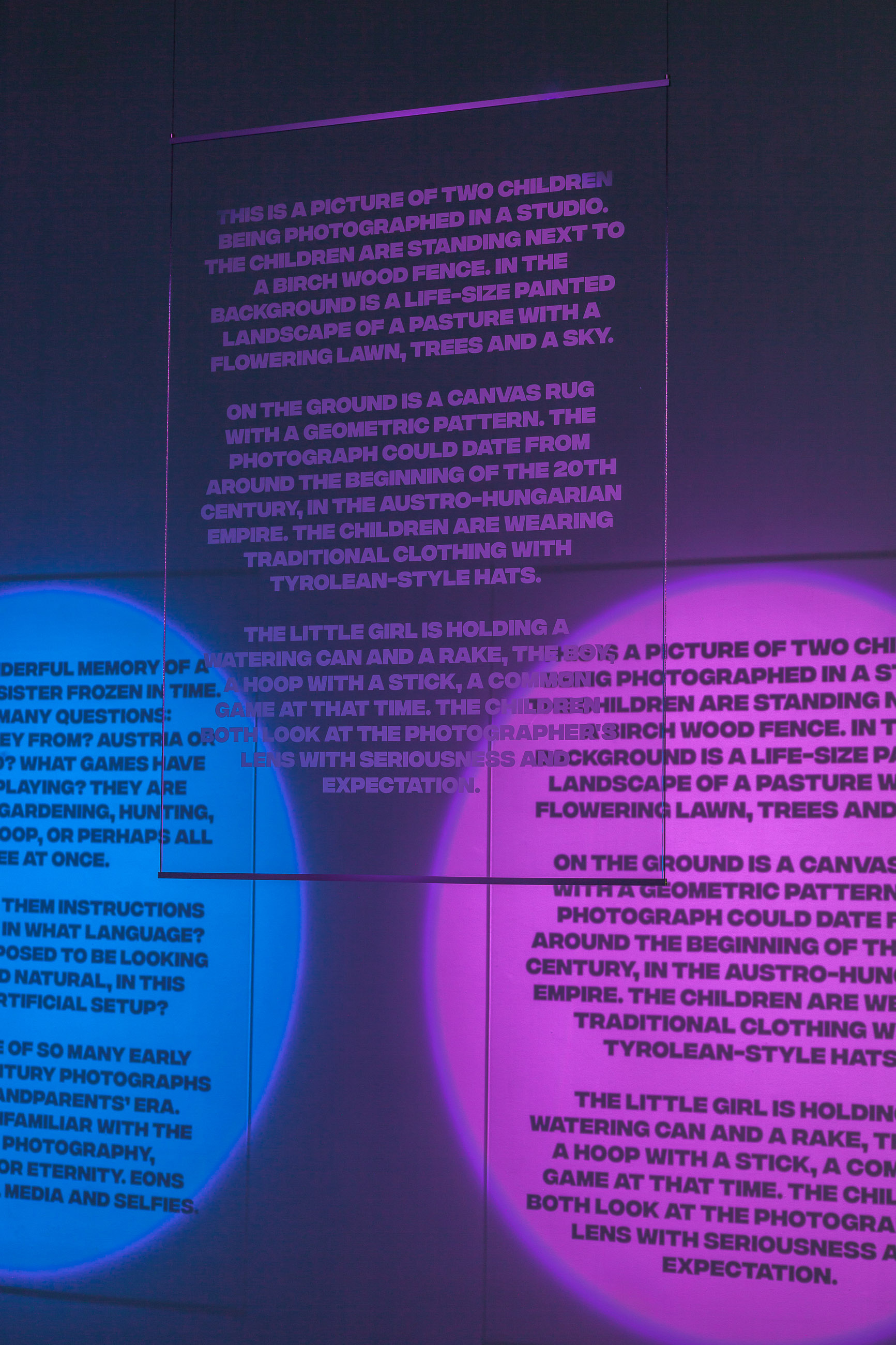Glass, Aluminium, Screen print, Pinpoint Spotlights, Coloured Gels
2023





‘Photographs Also Die’, attempts an unbiased reading of a single photograph. The work acts as a translation of a found image into text, which relies on the interpretation of three individuals that were chosen to undertake the task. In an effort to remove the subjectivity of the photograph the work solely exists as three descriptions of the original image.
Through the removal of visual representation, the focus turns to the descriptions. This absence challenges the way in which we rely on visual imagery and instead prompts us to engage with words as the primary means of understanding an image. The three descriptions highlight the diversity of perspectives when engaging with a photograph. Each one represents a subjective understanding of the image, allowing us to consider the varied lenses through which we understand the world.
The use of cyan, magenta and yellow lights make reference to the colour darkroom process. These colours are key components in the subtractive colour model, widely employed in analogue colour photography and printing processes. The darkroom is a space where the image is created; where paper is exposed to light, chemicals and colour. Here, this chemical and material transformation is echoed by the interplay of glass, etching and light. Through the glass panels, the etchings transform into text by their exposure to coloured light, thus becoming a system that engages with personal interpretation, whilst still having a foothold in photography.
The work explores a potential to transcend visual representation and engage with text as a means to challenge myths and authority associated with photographs. Through the different interpretations, the work contributes to a critical examination of the Western-centric and patriarchally-influenced discourse surrounding photography. By using participants from varying backgrounds, a new perspective is introduced that disrupts the assumed importance and neutrality attributed to the medium.
‘Photographs Also Die’ challenges us to reevaluate our understanding of photographic narratives, encouraging us to reflect on the layers of meaning embedded in every image. It is an invitation to explore the shadows, complexities, and nuances inherent in photography. It transcends conventional boundaries, inviting a contemplation of the photograph through its translation into text. The work is a testament to the enduring dialogue between photography and interpretation.
Through the removal of visual representation, the focus turns to the descriptions. This absence challenges the way in which we rely on visual imagery and instead prompts us to engage with words as the primary means of understanding an image. The three descriptions highlight the diversity of perspectives when engaging with a photograph. Each one represents a subjective understanding of the image, allowing us to consider the varied lenses through which we understand the world.
The use of cyan, magenta and yellow lights make reference to the colour darkroom process. These colours are key components in the subtractive colour model, widely employed in analogue colour photography and printing processes. The darkroom is a space where the image is created; where paper is exposed to light, chemicals and colour. Here, this chemical and material transformation is echoed by the interplay of glass, etching and light. Through the glass panels, the etchings transform into text by their exposure to coloured light, thus becoming a system that engages with personal interpretation, whilst still having a foothold in photography.
The work explores a potential to transcend visual representation and engage with text as a means to challenge myths and authority associated with photographs. Through the different interpretations, the work contributes to a critical examination of the Western-centric and patriarchally-influenced discourse surrounding photography. By using participants from varying backgrounds, a new perspective is introduced that disrupts the assumed importance and neutrality attributed to the medium.
‘Photographs Also Die’ challenges us to reevaluate our understanding of photographic narratives, encouraging us to reflect on the layers of meaning embedded in every image. It is an invitation to explore the shadows, complexities, and nuances inherent in photography. It transcends conventional boundaries, inviting a contemplation of the photograph through its translation into text. The work is a testament to the enduring dialogue between photography and interpretation.